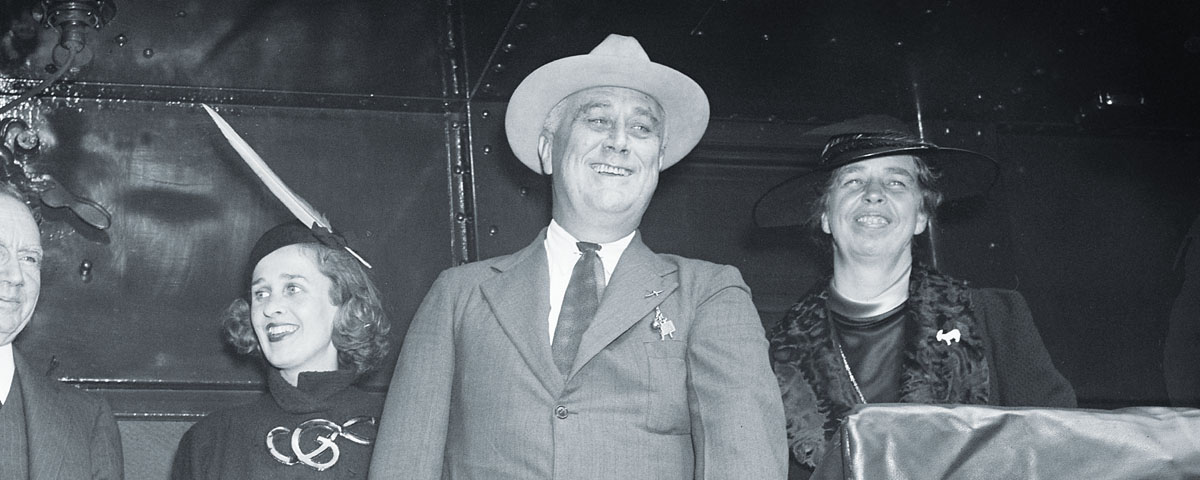[dropcap]F[/dropcap]ranklin Delano Roosevelt began the last year of his first term as President of the United States amid turbulence. As 1935 was ending, he shuttered the last dribs of the National Recovery Administration, a linchpin New Deal program that the Supreme Court had invalidated. Weeks into 1936, after a State of the Union address that staked FDR’s re-election run on the New Deal, the justices voided the Agricultural Adjustment Act in a way that called into question Roosevelt’s approach to regulating the economy. A month later, however, the high court found for the president, refusing, 8-1, to inhibit a government plan to sell and distribute power from the dams being built in the Tennessee Valley. Meanwhile, Congress overrode Roosevelt’s veto of a bill calling for immediate payment of World War I veterans’ much-disputed bonuses at a cost of $1.5 billion.
Making himself and the New Deal the issue in November, Roosevelt in effect set out to run against not an opposing candidate or even a political party but what he called the “old order” and “a generation of self-seekers.” Boldly declaring that he had “earned the hatred of entrenched greed,” he set plans to accept the Democratic nomination in Philadelphia in June. He would not have the services of longtime associate Louis Howe. The political adviser who had brought Roosevelt back from the brink in 1921 and helped him gain the New York governorship and then the presidency had died in April. James Farley replaced Howe as Roosevelt’s confidant and campaign manager.
In the spring, as the high court struck multiple times at federal and state regulation of the economy, Roosevelt tended his garden of political support, meeting with John L. Lewis of the United Mine Workers. By the time Democrats assembled in Philadelphia for a thoroughly scripted convention, FDR was in control. In the years since polio had cost him the use of his legs, he had honed his public life into a stellar performance as a man able to walk, managing through will and upper body strength to pivot from foot to foot provided someone, often son James, held him up. Not only Roosevelt but the country wanted to believe he was physically whole—an illusion always imperiled, as when, on June 26, 1936, FDR arrived by train from Washington at Philadelphia’s 24th Street station. Rain had been falling for hours; he was to speak in 35 minutes. At Franklin Field, his car went up an uncovered but curtained-off ramp. Out of sight from all but those in the platform party, the president was taken out of his car. His braces locked, he began his slow upward progress on James’s arm. Near the top, about to face the stadium’s thousands of occupants, Roosevelt leaned or reached to greet someone he knew and, still unseen by the crowd, lost his balance and was allowed to fall, facedown, on the wet, muddy ramp, his speech pages scattering. “Clean me up,” he barked furiously, and as his security people got him quickly to his feet and retrieved the now mud-daubed pages, he resumed his slow ascent. Seeing none of this, New York Times reporter Arthur Krock wrote, “One hundred thousand people rose and roared unmistakable acclaim as Mr. Roosevelt entered.” After brief remarks by a senator, the president came to the rostrum on James’s arm and began to speak. Even today, listening to his cool, measured delivery, it is difficult to accept that just minutes before, he had been badly shaken and was, as he later told his secretary, Grace Tully, “the damned, maddest white man…you ever saw.”
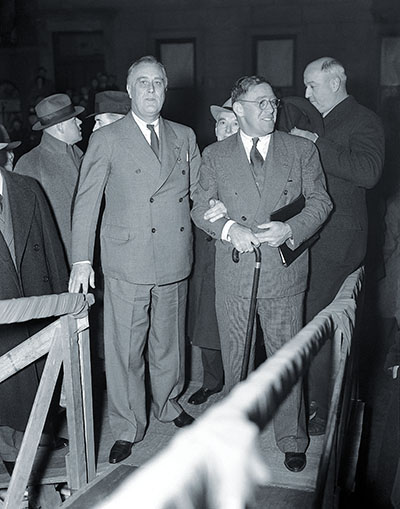
In his speech Roosevelt rode the ancien régime theme hard—“royalist,” “economic royalist” (twice), and “royalists of the economic order.” Invoking the Pauline triad of faith, hope, and charity, he closed with, among other exhortations, “Better the occasional faults of a government that lives in a spirit of charity than the consistent omissions of a government frozen in the ice of its own indifference.”
For the rest of the summer, FDR alternated between work and travel, sometimes recreational, sometimes fence mending, always political. In Topeka, Kansas, the Republicans nominated Alf Landon while third-party populist candidate William Lemke gathered support at the edges of the political spectrum. Lemke had the backing of radical right wing “radio priest” Father Charles Coughlin, whose weekly programs had 30 million listeners. Among other pundits, Walter Lippmann declared for Landon. When voting results from Maine, which still voted in September, produced a Landon victory in that state, the old bromide—“As Maine goes, so goes the nation”—echoed mindlessly. Still FDR would not be stirred from his serene campaigning-without-campaigning approach.
Only at the end of September, at the New York state Democratic convention in Syracuse, did Roosevelt formally open his pursuit of re-election. He called communism the campaign’s red herring, pointing to his long record of public service as evidence of his devotion to the American form of government. Noting that communism thrived on widespread economic maladjustment, he blamed Republican mismanagement for the economic disasters of 1929 to 1933. “Conditions congenial to communism were being bred and fostered throughout this nation up to the very day of March 4, 1933,” the president said. “Discontent and fear were spreading throughout the country. The previous national administration, bewildered, did nothing.” The rest of the Syracuse speech prefigured his campaign theme: the Republicans had caused the Depression and brought misery and danger to the nation, and he, his party, and the New Deal had come to the rescue. Roosevelt never mentioned communism again that fall.
During October, Roosevelt delivered a total of 19 “campaign addresses,” two just for radio audiences; six “addresses,” mostly ceremonial; 24 “extemporaneous rear platform remarks”; plus 29 other brief remarks. Each bore the same fundamental message—Roosevelt had assumed command of what seemed to be a sinking ship that had lost its way, and once he had the helm, great improvements could be felt by all.
GOP critics were focusing fire on the deficit. At Pittsburgh’s Forbes Field, where in 1932 he had attacked incumbent Herbert Hoover for spending too much money, Roosevelt met the matter head-on. “A baseball park,” he began, “is a good place to talk about box scores,” discussing the national economy and the election as if calling a ball game. “When the present management of your team took charge…you [had] voted for a change…to give the country a chance to win the game. And we are winning it.” His administration came to bat with the federal box score showing a net deficit of $3 billion left from Hoover’s watch, Roosevelt said. “To balance the budget in 1933 or 1934 or 1935 would have been a crime against the American people….When Americans suffered, we refused to pass by on the other side….My administration has increased the [net] national debt…eight billion dollars,” he continued. “Put that…eight billions…on the scoreboard, and let me tell you where the dollars went.” He ticked off $1.5 billion for the doughboy bonus, which removed a government obligation, and $6.5 billion for Civilian Conservation Corps camps, work relief, and conservation: “billions for security and a better life.”
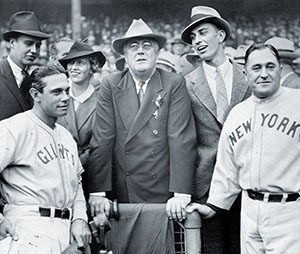
During 1935, not a single national bank had failed, a first in 55 years, he said, asking the crowd to recall the America of 1932. “As I drove through these great valleys, I could see mile after mile of this greatest mill and factory area in the world, a dead panorama of silent black structures and smokeless stacks,” Roosevelt said. “Today as I came north from West Virginia, I saw mines operating, I found bustle and life, the hiss of steam, the ring of steel on steel—the roaring song of industry.”
He closed by noting that the national income had risen from $38 billion in 1932 to $53 billion in 1935 and was still rising, making it likely that government receipts would, with no new taxes, take care of both ordinary and relief expenditures and thus balance the budget. The next day, in New York, Roosevelt went to a real ball game, throwing out the first pitch at the Polo Grounds in the second game of that season’s subway World Series. When he left, in the seventh inning, the Yankees were leading the Giants.
FDR undertook a 10-day circuit of a dozen mainly Midwestern states by rail. The presidential train was the largest ever: 11 cars, including two diners and a club car to accommodate more than 100 passengers, some 40 of them journalists. Agriculture Secretary Henry Wallace was aboard to confer with farm leaders. Western senators Key Pittman of Nevada, Joseph C. O’Mahoney of Wyoming, and Montana’s Burton Wheeler rode along from the beginning, and along the way dozens of others got on and off.
Each major speech along the way, and many of the trip’s minor addresses, had a single theme. In St. Paul, the topic was reciprocal trade agreements; in Omaha, farm policy; in Denver, FDR spoke of his water projects. In Detroit, two days after a crowd of 20,000 had responded coolly to GOP nominee Landon’s charge that the New Deal was “akin to fascism,” 150,000 people in the same public square heard Roosevelt call for more planning by automakers and other manufacturers to boost workers’ annual earnings. In Cleveland, the incumbent compared his administration’s help for every level of society with his predecessor’s trickle-down approach, which Roosevelt said never filtered more than halfway down the economic ladder.
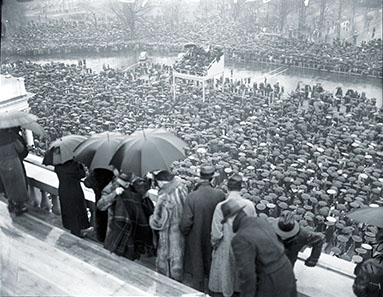
By the last day of the 5,000-mile trip, during which he delivered 60 speeches, Roosevelt and circle were buoyed by polls pointing to victory, though results of a Literary Digest survey held out for Landon.
Back at the White House, FDR mused one cocktail hour about how he would run against himself, imagining a close race—“a darned sight closer than Landon is doing.” Warming to the fantasy, he said if he were his opponent he would hammer the Works Progress Administration for its inefficiency and argue against trusting Democrats with Social Security and work relief.
“The more I think about it, the more I think I could lick myself,” Roosevelt concluded.
Again on the hustings, this time in New England, the president gave a centerpiece speech at Worcester, Massachusetts. In that nationwide broadcast he focused on tax policy, quoting Supreme Court Justice Oliver Wendell Holmes on taxes as the price of civilization.
Winding up his campaign in New York City, Roosevelt, whose administration had made no changes in restrictive immigration laws, attended a 50th-anniversary celebration at the Statue of Liberty, where he hailed “the steady stream of men, women, and children [who] brought to one new country the culture of a hundred old ones.”
By now bookmakers had Roosevelt a three-to-one favorite. Campaign strategist Farley predicted the Boss would carry 46 of 48 states. Alienated former ally Al Smith accused FDR of “preparing the way for a Communist-controlled America.”
In the traditional closing speech at Madison Square Garden, Roosevelt lit into his foes, tagging the old order “government by organized money” to a partisan crowd’s delight. “Never before in all our history have these forces been so united…against one candidate as they stand today,” he declared. “They are unanimous in their hatred for me—and I welcome their hatred.” Pivoting out of rancor to close on a theme of peacemaking and recovery, he left for Hyde Park to await November 3. On election eve, from his 12-by-12-foot study, Roosevelt gave a nonpartisan nationwide radio address, urging only that his fellow Americans vote for the candidate of their choice.
Roosevelt voted the next morning at the Hyde Park town hall, as he had been doing since 1903. After a quiet day at home, he settled in with family and a few members of his personal staff with pencils and pads and two press-association news tickers to tabulate results. Word came that New Haven, Connecticut, which FDR had won narrowly in 1932, had gone for him by 15,000 votes. A staff member confirmed the tally.
At this, FDR leaned back in his chair, blew a ring of smoke at the ceiling, and exclaimed, ‘Wow!’” said Roosevelt intimate Samuel Rosenman. By 10:30 p.m., with no West Coast votes in, FDR abandoned his count and joined a larger party in the library for sandwiches and, almost certainly, a cocktail. Landon waited until 1:30 a.m. to send a telegram of concession, by which time the president had greeted a torchlight parade of neighbors and gone to bed.
When all the results were in, it was and remains the greatest electoral triumph in modern American history. Roosevelt carried all the states, save Maine and Vermont, receiving 60.8 percent of the vote, up from 57.4 percent in 1932. Landon received a million more votes than Hoover, but since almost six million more people voted, his share of the popular vote was smaller: 36.5 percent to Hoover’s 39.7 percent. Lemke garnered 882,000 votes; the left-wing vote in the East fell to 268,000—188,000 for Socialist Norman Thomas and 80,000 for Communist Earl Browder.
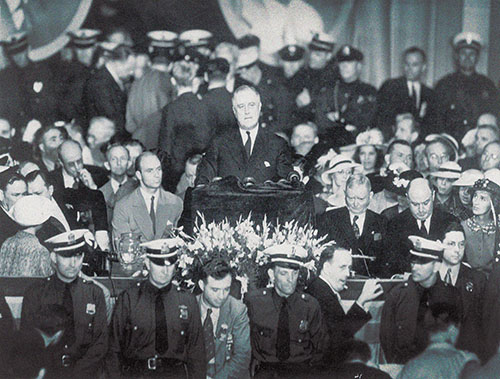
Roosevelt’s coattails continued strong: In the Senate, whose incumbent candidates had been elected in 1930, the Democrats picked up six seats, for a total of 75, while the Republicans lost nine, dropping to 16 of 96. The already lopsided House added 11 more Democrats, for a total of 331, while Republican numbers shrank to 89, the lowest figure since 1891. Most congressional independents—four in the Senate, 13 in the House—usually voted with the Democrats and included iconic former Republicans George Norris of Nebraska and Wisconsin’s Robert La Follette.
The 1936 vote was what many students of politics describe as “a transforming election” that made the Democratic Party the majority party in the nation for many elections to come. It welded disparate groups of voters into an effective bloc. The Roosevelt coalition retained the party’s historic components—Southerners, Catholics, and Jews—plus urbanites the disaffected Smith had drawn into the party, while adding most trade unionists, most ethnic groups and blacks, and the professoriat. Though Republican candidates would prevail in seven of the next 15 presidential elections, from 1940 to 1996, between the Roosevelt era and 1995 the GOP controlled both houses of Congress only during 1953-55.
The lopsided result amazed the nation. Pressed by reporters to reveal his four sets of personal pre-election predictions of Electoral College results—well-advertised as dated and stored in a sealed envelope in his safe—Roosevelt feigned reluctance because his calls were “so far off,” but finally read them aloud: January 30, Democrats 325, Republicans 205; June 5, Democrats 315, Republicans 216; August 2 FDR 340, Landon 191; November 1, FDR 360, Landon 171. Apologizing for being so wrong, he did not point out that all four predictions were not only well below the true result, 523 to 8, but also the 1932 tally of 472-59.
“What frightened you?” a reporter asked.
“Oh, just my well-known conservative tendencies,” Roosevelt said, evoking much laughter.
Most of the time between the election and Christmas was taken up with a cruise to Buenos Aires and back to kick off the Inter-American Peace Conference on December 2. That ruled out the otherwise sacrosanct Thanksgiving at Warm Springs, Georgia, but the by now traditional large Roosevelt family Christmas at the White House continued, with, as the press noted, one minor innovation. After Franklin made his annual Christmas greeting to the nation and formally “lit” the national yuletide tree in Lafayette Park, Eleanor, in an activity not previously reported, “went to speak at another Christmas tree set up in an alley in Washington’s Negro district.”
Much of the last weeks of the year were devoted to preparing various documents necessary for the opening of the second term—the State of the Union message, the budget message, and the second inaugural, all of which would occur in a span of fewer than three weeks. In addition, as Roosevelt explained to the press, work on a reorganization of the government would continue. There was a small rearrangement of his personal staff. Advance man Stephen T. Early moved into Louis Howe’s old office—but did not assume his title—and the president’s son Jimmy moved into Early’s workspace and was assigned Howe’s former secretary. About the legislative agenda for the New Year, however, the president continued to say nothing. ✯
This story was originally published in the July/August 2016 issue of American History magazine. Subscribe here.

